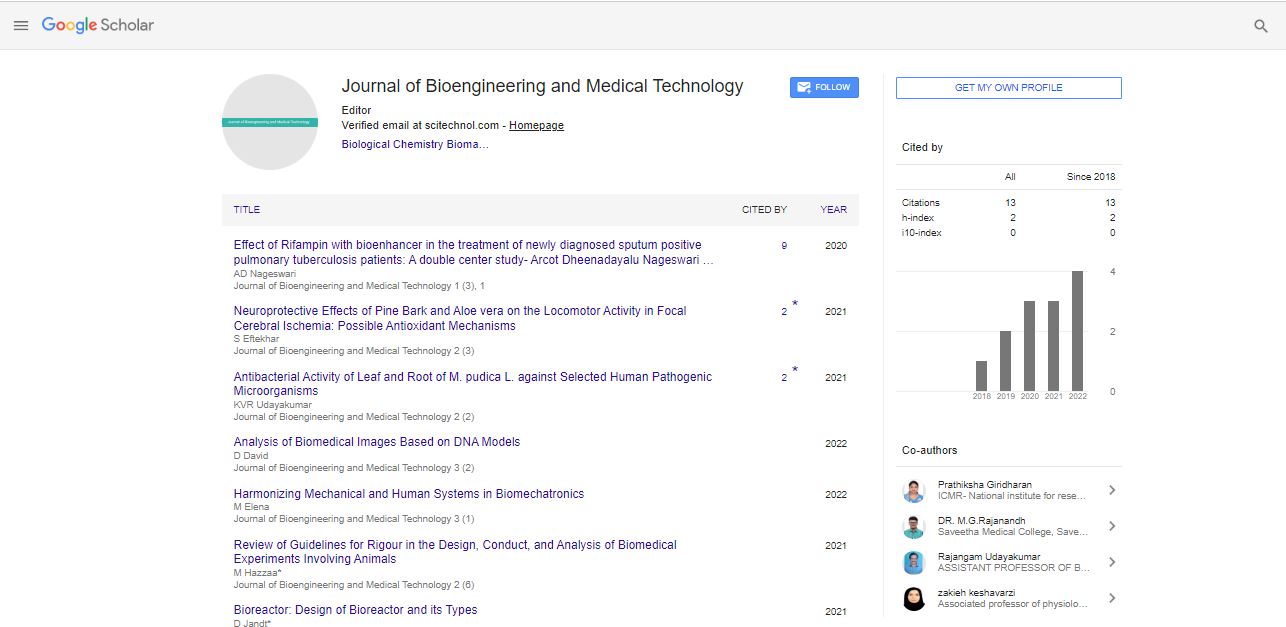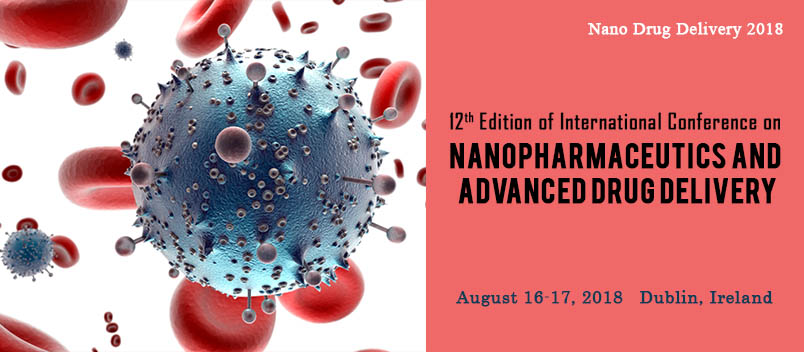Short Communication, J Bioeng Med Technol Vol: 4 Issue: 2
Engineering Solutions for Rehabilitation and Assistive Technologies
Firas Zahwe*
1Bioengineering and Medical Technology Department, Imperial University, London, United Kingdom
*Corresponding Author: Firas Zahwe,
Bioengineering and Medical Technology
Department, Imperial University, London, United Kingdom
E-mail: firazah@2456.edu
Received date: 22 May, 2023, Manuscript No. JBMT-23-107421;
Editor assigned date: 24 May, 2023, Pre QC. JBMT-23-107421 (PQ);
Reviewed date: 15 June, 2023, QC No. JBMT-23-107421;
Revised date: 22 June, 2023, Manuscript No. JBMT-23-107421 (R);
Published date: 29 June, 2023, DOI: 10.35248/jbmt.1000073
Citation: Zahwe F (2023) Engineering Solutions for Rehabilitation and Assistive Technologies. J Bioeng Med Technol 4:2.
Description
Rehabilitation and assistive technologies play a pivotal role in enhancing the quality of life and promoting independence for individuals with disabilities and impairments, that delves into the engineering solutions that have emerged in the field of rehabilitation and assistive technologies, exploring the innovative developments, challenges, and the potential of these technologies to address various physical and cognitive limitations. By merging engineering expertise with a focus on human-centric design, this analysis showcases the positive impact these technologies can have on the lives of millions of people worldwide [1].
Rehabilitation and assistive technologies have rapidly evolved over the years, transforming the way people approach disability and impairments. With advancements in engineering and technology, innovative solutions have emerged to address the unique challenges faced by individuals with disabilities, aiming to shed light on the diverse range of engineering solutions in the field of rehabilitation and assistive technologies, with a focus on how these advancements have improved the lives of those in need [2-5].
Engineering solutions for physical rehabilitation
Prosthetics: Modern prosthetic limbs have become more sophisticated and functional, integrating advanced materials, sensors, and machine learning algorithms. These engineering marvels enable amputees to regain dexterity and mobility, with some devices offering sensory feedback, enhancing the user's proprioception and control.
Exoskeletons: Powered exoskeletons have emerged as groundbreaking rehabilitation tools, assisting individuals with impaired mobility due to spinal cord injuries or neuromuscular conditions. These wearable devices provide support, stability, and enhanced mobility, promoting gait rehabilitation and fostering greater independence [6,7].
Orthotic devices: Customizable orthotic devices designed using computer-aided design and 3D printing have made substantial progress in correcting skeletal deformities, improving body alignment, and supporting rehabilitation efforts [8].
Engineering solutions for cognitive rehabilitation
Brain-Computer Interfaces (BCIs): BCIs have opened up new possibilities for individuals with severe motor impairments by establishing direct communication channels between the brain and external devices. These interfaces enable users to control computers, robotic limbs, and even their environment, significantly enhancing their independence and quality of life [9].
Assistive communication devices: Engineering advancements have revolutionized Augmentative and Alternative Communication (AAC) devices. Incorporating natural language processing and machine learning, these technologies facilitate efficient communication for individuals with speech and language disabilities.
Human-centric design and user experience
An integral aspect of successful rehabilitation and assistive technologies lies in their human-centric design and user experience. Engineers collaborate with therapists, clinicians, and end-users throughout the development process, ensuring that these technologies meet the specific needs and preferences of the individuals they are intended to assist. User feedback and iterative design plays a vital role in optimizing the effectiveness and acceptance of these solutions [10].
Challenges and future directions
Affordability: Many cutting-edge rehabilitation and assistive technologies remain expensive, limiting access for those in need. Engineers and policymakers must work collaboratively to drive down costs and make these solutions more affordable and accessible to all.
Interoperability: Ensuring compatibility and interoperability between various assistive technologies is vital to provide a seamless user experience and enable seamless communication and data sharing across devices [11].
Ethical considerations: As technology advances, ethical considerations regarding privacy, autonomy, and data security need to be addressed, especially when dealing with brain-computer interfaces and other invasive technologies.
Conclusion
Engineering solutions in the realm of rehabilitation and assistive technologies have ushered in a new era of possibilities for individuals with disabilities. These innovations have the potential to empower millions worldwide, fostering independence, and improving overall quality of life. By prioritizing human-centric design, addressing challenges, and working towards greater accessibility, engineers can continue to make transformative contributions to this field, benefiting society as a whole.
References
- Passwell JH, Harlev E, Ashkenazi S, Chu C, Miron D, et al. (2001) Safety and immunogenicity of improved Shigella O-specific polysaccharide-protein conjugate vaccines in adults in Israel. Infect Immun 69:1351-1357.
- Kouitcheu LB, Tamesse JL, Kouam J (2013) The anti-shigellosis activity of the methanol extract of Picralima nitida on Shigella dysenteriae type I induced diarrhoea in rats. BMC Complement Altern Med 13:1.
- Dutta S, Ghosh A, Ghosh K, Dutta D, Bhattacharya SK, et al. (2003) Newly emerged multiple-antibiotic-resistant Shigella dysenteriae type 1 strains in and around Kolkata, India, are clonal. J Clinic Microbiol 41:5833-5834.
- Sivapalasingam S, Nelson JM, Joyce K, Hoekstra M, Angulo FJ, et al. (2006) High prevalence of antimicrobial resistance among Shigella isolates in the United States tested by the National Antimicrobial Resistance Monitoring System from 1999 to 2002. Antimicrob Agents Chemother 50:49-54.
- kumar Oli A, Ashajyothi C, Chandrakanth RK (2015) Prevalence and antibiotic susceptibility pattern of fluoroquinolone resistant Shigella species isolated from infants stool in Gulbarga district, Karnataka, India. Asian Pac J Trop Dis 5:116-120.
- Clark AM (1996) Natural products as a resource for new drugs. Pharma Res 13:1133-1141.
- Cordell GA (2000) Biodiversity and drug discovery a symbiotic relationship. Phytochem 55:463-480.
- Rabbani GH, Albert MJ, Rahman H, Islam M, Mahalanabis D, et al. (1995) Development of an improved animal model of shigellosis in the adult rabbit by colonic infection with Shigella flexneri 2a. Infect Immun 63:4350-4357.
- Ahmed ZU, Sarker MR, Sack DA (1990) Protection of adult rabbits and monkeys from lethal shigellosis by oral immunization with a thymine-requiring and temperature-sensitive mutant of Shigella flexneri Y. Vaccine 8:153-158.
- Arm HG, Floyd TM, Faber JE, Hayes JR (1965) Use of ligated segments of rabbit small intestine in experimental shigellosis. J Bacteriol 89:803-809.
- Dutta NK, Habbu MK (1955) Experimental cholera in infant rabbits: a method for chemotherapeutic investigation. Br J Pharma Chemother 10: 153.
 Spanish
Spanish  Chinese
Chinese  Russian
Russian  German
German  French
French  Japanese
Japanese  Portuguese
Portuguese  Hindi
Hindi 
